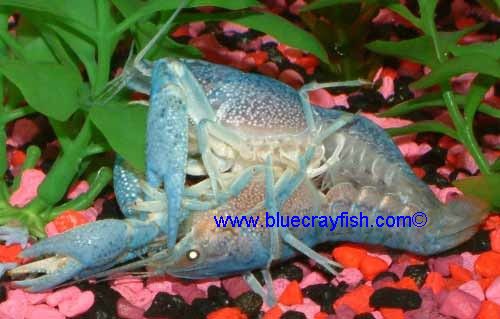North American crayfish should be kept at 55-70 degrees Fahrenheit. 72 degrees is the outside safe limit, but 70 or under is best.
1 crayfish (up to 6-7 inches long) per 10 gallons is the max. cray-bio-load.
Never mix different species of crayfish in the same tank.
When putting a crayfish into a tank, gently hold it upside down for a few minutes just under the surface of the tank water, to give any trapped air bubbles in the gills a chance to escape.
WHAT TO DO IF YOU FIND YOUR CRAYFISH AFTER IT HAS ESCAPED FROM YOUR TANK: If a cray has been out of water for any significant period of time, then DO NOT put the cray directly into deep water (i.e. its tank). The crayís gills need time to slowly re-adjust to water, to prevent the possibility of drowning. Instead, put the cray into a bucket that has tall enough sides to be sure the cray cannot escape, and put just enough water into the bucket to completely cover the cray when it's standing on all its legs (NO MORE!). Also put a flat "cray-comfortable" rock in the bucket, so the cray can climb up on the rock, out of the water, if it wants to. Leave the cray in the bucket for 24 hours. Then, if the cray is still doing well, pick it up and hold it upside down for a few minutes just under the surface of the tank water, to give any trapped air bubbles in the gills a chance to escape. ONLY then, put the cray all the way back into the tank.
In general, with almost all species of crays, only have one crayfish per tank. Crayfish are aggressive and territorial. While there are exceptions to this rule, there are no guarantees of peaceful cohabitation, and only a relatively experienced and/or knowledgeable crayfish aquarist should attempt to house multiple crayfish in the same tank. While success in this area depends on science, it is really an art, not a science, and personal experience is essential. IF you do house multiple crays in the same tank, make sure to add lots of hiding places (plants, rocks, caves, plastic tubes, or possibly even netting), so the crays can hide from each other.
If you house multiple crays in the same tank, introduce them to the tank all at the same time. If you add one and add another later, the first one is much more likely to view newer ones as invaders and attack.
Each cray needs his own 3 sided hiding place to feel secure. ABS pipe or PVC pipe or a yellow transparent gerbil tube or a cave, etc.
Crayfish will drown if they are kept in water that is significantly over their head for 3-6 hours without supplemental oxygenation. This makes air bubblers mandatory, and long bubble walls are the best. Filter oxygenation is not enough, because filters fail way more often than air pumps. IF the power goes out, gather up your crayfish and place each one into its own tall container with just enough water to completely cover the crayfish when itís standing on all of its legs (NO More!), and put a flat comfortable rock in each bucket so that the crayfish can climb out of the water if desired. This will prevent them from drowning. If you have to house your crayfish this way for any length of time, change all the water at least once a week, and no filter is necessary in a bucket house. In an aquarium crayfish need working filters. The best solution to prevent crays drowning, is to have an uninterruptible power supply powering your air pump(s), so that if the power does go out, the U.P.S. will simply take over, and oxygenation will continue.
Crayfish love darkness, so don't keep the tank light on a whole bunch, unless you are in the room looking at them, or unless you are meeting the tank's minimum lighting requirements for the plants, like 5-8 hours per day.
Crayfish are escape artists, because they are curious, and love to climb. Seal off all possible escape routes, especially the filter opening. If your cray escapes, it will dehydrate and die, in a few hours. Very good ways to seal off the tank are: a) cut an X in the center of a small cool whip lid and slide it ALL the way up the filter intake until it canít be slid anymore (this blocks the filter opening from the inside of the tank), AND b) use aluminum foil and rubber bands and / or scotch tape to seal off the filter opening from the outside of the tank lid. If you do this, donít let the aluminum foil touch the actual tank water, as metal in water is not good for aquarium inhabitants.
There are very few good tankmates for crays, because crays eat tankmates and tankmates eat crays. Cichlids are known for eating crays.
Some apparently good tankmates that MIGHT or MIGHT NOT become cray food are white cloud mountain minnows, rosy red minnows, and rainbow darters. Goldfish get BIG and POOP a LOT. I don't recommend them with crays.
The tank must be cycled: ammonia=0, nitrites=0, nitrates 10-20 (40-80 means change the water now!), PH 7 or higher. Crayfish should not be in water with a PH of less than 7. Water parameters should be checked every 2-3 weeks, to make sure the conditions are good, healthy and stable. If you are uncomfortable with your water parameters for any reason, check them more often, so you will know when to take corrective action. Weekly water changes of 20-30% are recommended. Bottled spring water or tap water that has been dechlorinated should be used. When changing water, make sure the new water is about the same temperature as the existing water, to prevent temperature shock to the crayfish.
When your cray moults, leave the old shell in for one week, and then remove whatever (if anything) is left. The cray will eat the old shell to harden his new shell.
Do not feed your cray for a few days after he moults, because he will eat the old shell before any food you put in. So the food you put in will spoil.
When crays moult, they are very soft, weak, and vulnerable for about a week. So leave them in darkness, undisturbed as much as possible, during that time.
Crays should be fed shrimp pellets or crab and lobster bites as a staple, about the equivalent of ONE 3/4" pellet every day, at most. They also enjoy veggie treats from time to time (frozen peas, romaine lettuce, raw potato, carrot, cucumber, etc). And the occasional live minnow treat may be appreciated, too. Lettuce has to be weighted down with a rock. Use a rubber band to bind it to a rock. Do not over feed. The uneaten food will dirty the water; also over feeding your crayfish will cause them to be unhealthy, developing gelatinous shells.
Never put seashells in an aquarium with crayfish in it, because they cause unhealthy PH fluctuations.
Never feed live or uncooked shrimp to your cray. Shrimp can carry a disease that can be fatal to crays.
Never use copper-based medicine in a tank that has crays in it. The copper will kill the cray.



.jpg)
